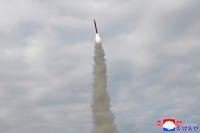The Navy went ahead with what was billed as the largest shipbuilding contract in its history Monday, awarding $22.2 billion for at least nine new copies of the Virginia-class, fast attack nuclear submarine amid concerns over budgeting and strains on the industrial base.
The contract with Huntington Ingalls Industries Inc., of Newport News, Virginia, and the Electric Boat Division of General Dynamics in Rhode Island carries an option for a 10th submarine, which would bring the total award to more than $24 billion, the Navy said.
One of the challenges to be met by the firms will be in building what is essentially an entirely new boat in the Virginia class.
The 18 Virginia-class subs already built weigh 7,800 tons and have a hull length of 377 feet, but the new Block V versions will have a hull length of 460 feet and weigh 10,200 tons, Sen. Jack Reed, D-Rhode Island, ranking member of the Senate Armed Services Committee, said in a release.
Related: Navy Awards Massive $22.2 Billion Contract for 9 New Attack Submarines
In addition, eight of the nine new boats, expected to come online between 2025 and 2029, will carry the Virginia Payload Module, an additional, 84-foot-long, mid-body section with four vertical launch tubes for storing and launching additional Tomahawk cruise missiles and underwater unmanned vehicles.
In a report last month, the non-partisan Congressional Research Service said there were several issues with the contract then being considered by the Navy, including the ongoing impasse in Congress over the fiscal 2020 budget now under a continuing resolution set to expire on Dec. 21.
The report by CRS also questioned "whether the Navy has accurately priced the work it is proposing to do" on the new subs, and whether the service has taken into account "the potential industrial-base challenges of building both Columbia-class [ballistic missile] boats and Virginia-class attack submarines at the same time."
In addition, the Congressional Research Service cited the "technical risk in the design for the latest version of the Virginia-class submarine" to include the Virginia Payload Module.
The work at Huntington Ingalls would also come while the Newport News facility continues to fix persistent problems with the weapons elevators on the new Gerald Ford aircraft carrier, and prepares to build two more carriers in the Ford class.
However, Navy officials said the service is up to the task of managing the burst of activity in nuclear shipbuilding.
The service has consistently said that building the new Columbia class of ballistic submarines is the top priority, but "our whole philosophy going into this is -- get Virginia as a stable foundation, which then we can build Columbia on top of," James Geurts, the assistant secretary of the Navy for research, development and acquisition, said in a roundtable with defense reporters Monday.
Rear Adm. David Goggins, the program executive officer for submarines, said at the roundtable that the main concern in the contract award is "the overall balance between Virginia, Columbia and the Ford programs," according to U.S. Naval Institute News.
"The considerations were the technical risk, the industrial base capability and capacity, and the fleet requirements. So this is really the right balanced approach from a fleet perspective," Goggins said.
In a statement, David Bolcar, Newport News' vice president of submarine construction, said the contract award "maintains the Virginia-class build rate that provides continued stability to our workforce and to the 5,000 suppliers that will support submarines for the next decade."
"This contract also continues the two per year construction cadence essential to sustaining production efficiencies, while ensuring our national security and the Navy's continued undersea superiority," he said.
Reed hailed the contract as "a major win for Rhode Island that will bring a host of economic benefits to the state. It means submarine production at Quonset stays on course and continues full speed ahead for the next decade and will lead to further jobs and investment in the state."
-- Richard Sisk can be reached at Richard.Sisk@Military.com.
Read More: Navy Changes Tour Lengths for 50,000 Sailors and Boosts Reenlistment Bonuses














